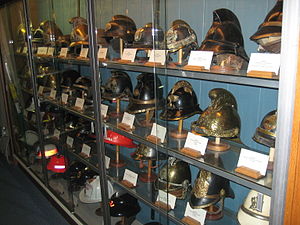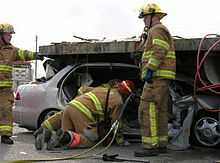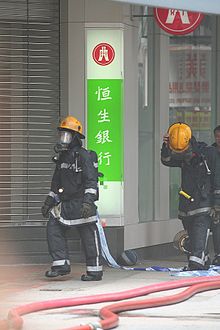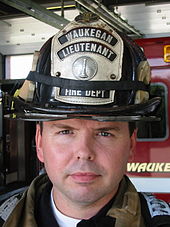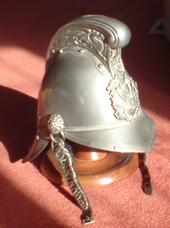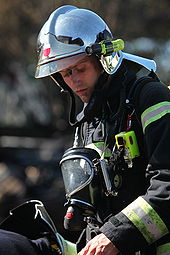- Firefighter's helmet
-
For centuries, firefighters have worn helmets to protect them from heat, cinders and falling objects.
Contents
Modern structural helmet
Modern structural helmets (that is, intended especially for structure fires) are worn in the United States and Canada, as well as Britain, Australia and in parts of Asia (notably Hong Kong, Macau, Taiwan and Guangzhou). Structural helmets are made of either thermoplastic or composite material. The brim at the rear of the helmet is longer than the front and a face shield(s) is usually attached to the front. Newer "Metro" - The name given by several leading helmet manufacturers - helmets are also much lighter than both leather and composite traditional helmets.
The Leatherhead
The leatherhead is a term describing an old style leather helmet used by many firefighters in the US and Canada. Leatherhead is also slang for a firefighter who uses the leather helmet. The leather helmet is also an international symbol of firefighters from the earlier years of firefighting. Almost always, traditional leather helmets have a brass (eagle in US, beaver in Canada) adornment affixed to the top front of the helmet that secures a leather shield to the front of the helmet.
The Brass Eagle and Beaver (United States and Canada)
The brass eagle or beaver which holds the top of the front piece to the leather helmet will often become damaged with wear - The eagle is a traditional symbol of the United States.. Its origins can be traced to around 1825 when an unknown sculptor created a commemorative figure for the grave of a volunteer firefighter. Firefighters were not wearing eagles prior to this, but it has been part of fire helmets ever since. The beaver ornament, adorned on many Canadian firefighter's helmets, is said to represent the relentless hard work, focused mission and undying dedication that North American firefighters are known for.
Many fire departments have a traditional helmet with more modern plastic and composite helmets that have no eagle or beaver device - Jokingly referred to as "salad bowls" and "slick tops" for their streamlined shape. However, many firefighters and fire departments still retain the traditional helmet (composite or leather) as a matter of tradition and comfort.
Forest Fire Helmets
Forest firefighters in North America have worn a variety of helmets:
- Hard hat type with full brim (similar to Brodie helmet) or cap brim (front only construction type) used with goggles and/or ear protection attached to brim
- modern metro type structural fire helmets used with goggles
Merryweather
Merryweather helmets were used by British fire brigades from the Victorian era (1868) until well into the 20th Century. Leather helmets were first used by insurance firefighters in the 18th and 19th Century.[1] The Merryweather was modelled after helmets worn by cuirassiers of the French Army, the helmets were made of brass or nickel. Metal helmets are conductive, which was a safety hazard as use of electricity became widespread, due to the risk of live wires falling from overhead. As a result they were slowly replaced by the modern structural fire helmets, similar to the ones used in North American jurisdictions.
Beginning in 1935, the metal Merryweather was replaced with a compressed cork version made by Cromwell Helmets. Gone was the decorative features on the comb with a streamline helmet similar to ones worn by London firefighters from 1833 to 1868.[2]
During World War II (1941 and until 1948), firefighter in London wore Brodie helmets instead of the Cromwell Merryweathers.[3]
From 1965 to the 1990s, a variant called County Pattern was introduced with a simple cork based headgear for British firefighters.[4] This design won over fire brigades over designs that deviated from the Merryweather (Model 3871)
The compressed cork design lasted over six decades with a failed trial of a plastic version (1950s and late 1960s) and leather made Hendry Metro helmets.[5]
By 1989, the Cromwell Merryweather and cork gave way to even lighter modern structural thermoplastic helmets.
German DIN fire helmet
In Germany most of the fire brigades still use the old German DIN fire helmet. This helmet is designed according to the old German standard DIN 14940 dd. approx. 1972. The helmet is made of aluminium alloy, it is painted with a yellow-green fluorescent colour and provided with a white reflecting stripe and a black leather neck protection. Most fire brigades use the helmet with an easily mountable visor. The design of the helmet is based on the German military steel helmet of the first world war. The German DIN fire helmet does not correspond to the presently valid European EN 443 standard for fire helmets as it is conductive. It is allowed to use the existing aluminium DIN fire helmets but not to obtain new ones for fire services. Some manufacturers produce fire helmets made of glass fibre reinforced plastic having exactly the look of the old German DIN fire helmet and corresponding to the European EN 443 standard. To avoid a different look of helmets in one fire brigade most of them obtain new helmets looking like the old DIN fire helmet.
F1 helmet
The F1 helmet is a modern firefighter's helmet made in France by Gallet, a subsidiary of MSA, who also produce the SPECTRA military helmet. In service since 1985, the F1 helmet provides protection against impact, fires and electricity, fulfilling the EN 443 European standard.
The F1 was an answer to a requirement of the Paris Fire Brigade for a replacement of the previous helmet (Casque modele 1933 was similar to the Merryweather) which dated back to 1933; these provided insufficient protection for the face and back of the head, and were not thermally insulated. The F1 helmet is hand made, using synthetic materials often covered with galvanised nickel. It can include masks, communication systems and other accessories.
The F1 has been used by the Paris Fire Brigade since August 1985, and has been widely adopted by all of the French fire services, gaining export success in over 85 countries, including fire departments in Quebec (Ville de Quebec), Canada, Singapore, China and Japan (notably in Tokyo).
Helmet colors
In some countries, most notably the United States and the Commonwealth Realms, the colour of a firefighter's helmet often denotes the wearer's rank or position. In Britain and its former colony Hong Kong, most firefighters wear yellow helmets, but watch managers (sub officers) and above wear white helmets; rank is further indicated by black stripes around the helmets. In Canada regular firefighters wear yellow or black with captains with red and senior command offices in white. Likewise in the United States, red helmets denote company officers, while white helmets denote chief officers. However the specific meaning of a helmet's color or style varies from region to region and department to department.
The South Australian Country Fire Service like many Australian Fire Services, have specific colours for specific roles. White helmets are for Firefighters (with a red stripe for Senior Firefighters). Lieutenants have yellow helmets, Captains have yellow with a red stripe, Deputy Group Officers and above have red helmets, while paid staff have a blue stripe on their helmet.
See also
- Fire safety
- Glossary of firefighting equipment
- Glossary of firefighting terms
- Custodian helmet - worn by British and Commonwealth police forces
References
- ^ http://www.london-fire.gov.uk/Uniforms.asp
- ^ http://www.spanglefish.com/hot-lids/index.asp?pageid=277513
- ^ http://www.spanglefish.com/hot-lids/index.asp?pageid=277513
- ^ http://www.spanglefish.com/BarriesFireHelmets/index.asp?pageid=87560
- ^ http://www.spanglefish.com/BarriesFireHelmets/index.asp?pageid=87560
External links
- San Francisco Fire Museum page with pictures
- Fire helmets and helmet images in the Staten Island Historical Society Online Collections Database
- msa-gallet.fr F1-SF helmet Manufacturer's web site
- Killorglin Fire & Rescue Killorglin Fire & Rescue site includes a breakdown of the parts of the Gallet helmet
- Der Feuerwehrhelm A helmet collection: See fire helmets of the past and the future, from Germany and the whole world
- Caschi da Pompiere - Fire helmets A blog from an Italian collector, from all over the world.
Categories:- Helmets
- Firefighting equipment
Wikimedia Foundation. 2010.

